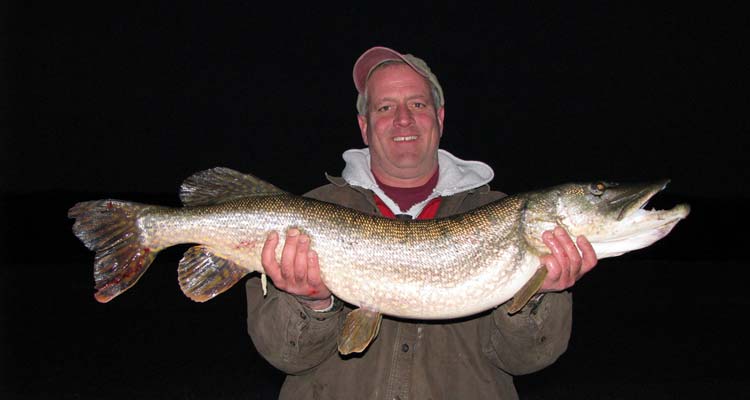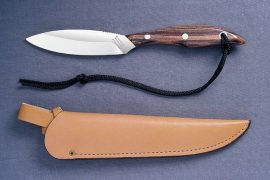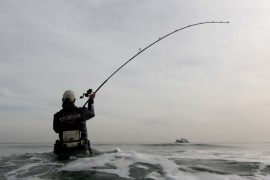
While exotic species grab the headlines, the truth is that most of the freshwater fish we think of as belonging to New England aren’t native at all.
Years ago, while walking along the shoreline of the Charles River in downtown Boston throwing a spinnerbait for summer largemouths, I was stopped dead in my tracks by the sight of two glowing, pinkish-white creatures milling about in the shallows. As I snuck closer, I saw it was a pair of fish that resembled the tropical cichlids I used to sell when I worked in a pet shop. Their behavior looked familiar too. For a few minutes, I watched the pair of 10-inch fish vigorously defend a small patch of bottom, chasing away two carp, a 2-pound largemouth and numerous bluegills. Typical cichlid spawning behavior, I thought. But could some sort of tropical cichlid really be spawning in the Charles?

They wanted nothing to do with my spinnerbait, but I eventually got one to attack a bare bronze hook, and I snapped a few photos. Karsten Hartel, the Curatorial Associate in Ichthyology at Harvard’s Museum of Comparative Zoology—in other words, a man who knows a whole lot about fish—identified the fish to be a Nile tilapia, Oreochromis niloticus, a cichlid fish native to Africa and of a size and coloration suspiciously similar to those sold in Chinatown’s live fish markets. An aberration, perhaps, but the spawning behavior, and the fact that I’ve seen as many as a dozen of these fish at the same location in each of the last four years, lends credence to the hypothesis that they may in fact be surviving New England’s winters and reproducing, despite their tropical roots.
The tilapia episode is only the most recent chapter in the long history of nonnative fish introductions into New England waters, a story that dates back to the 17th century. While freak encounters in New England waters with tropical species such as piranhas, walking catfish, pacu, or that poster child of nonnative fishes, the northern snakehead, may get all the press, a look at established, reproducing species reveals that most of the freshwater fish that we tend to think of as native to New England were completely alien to our waters until the 1800s. According to Hartel, 47 percent of the primary freshwater fish species (fish that spend their entire lives in freshwater) reproducing in Massachusetts are not native to the state, but have been introduced by humans. Most of these introductions have not been accidental, but intentional, often undertaken by state or federal agencies to provide New England’s residents with a ready source of nutrition and sport.

A survey of New England’s freshwater ecosystems prior to the 17th century would seem almost foreign to any freshwater angler used to targeting largemouth bass, northern pike, carp or virtually any other game fish. Small fish like darters, sculpins and especially minnows, dominated the fish diversity composed of 50 or so species. And the apex predators, depending on the locale, were yellow perch, brook trout and chain pickerel.
Before taking a closer look at the cast of interlopers, let’s define the terminology used to describe “alien” species. A nonnative species is, as you’d expect, a species not indigenous to a certain region. All of the nonnative species discussed here are introduced—that is, brought into the ecosystem by humans and not by a natural extension of their range. One type of nonnative species is an exotic species, a species not native to the country into which it was introduced. Another type is a transplant, which is a species moved within its native country into a watershed in which it is not native. The National Invasive Species Council (NISC) defines an invasive species as “a species that is nonnative to the ecosystem under consideration and whose introduction causes, or is likely to cause, economic or environmental harm or harm to human health.” Not all of New England’s nonnative fishes can be considered invasive, but there’s little doubt that each has in some way altered the environment in which it lives.

The first species on record as having been introduced into New England waters is the goldfish Carassius auratus, a close relative of the carp native to much of eastern Asia. They were brought to North America as early as the late 17th century by British settlers, who released them into neighborhood waters with the hope of adding the ornamental species to the local waters. In the late 1800s, the United States Fish Commission, a predecessor of today’s National Marine Fisheries Service, bred and raised the species, distributing them nationwide to meet demand for ornamental fish ponds and aquaria. Those initial introductions have been augmented over the centuries by aquarium releases and escapes from private ponds and other facilities, resulting in a wide diversity in the shapes and colorations of wild goldfish. They’re sometimes caught by anglers targeting carp and are a frequent site in more urban areas, their presence often betrayed by their bright orange hue.
Treasured by some, abhorred by others, the goldfish’s close relative, the common carp, is one of the most prominent nonnative species found in our waters, and one that can truly be called “invasive.” Native to much of the Eurasian landmass, the species was first brought to the United States in the mid-nineteenth century, both by private parties and the federal government. The real arrival of the common carp, however, is considered to be the shipment of 345 adults that the U.S. Fish Commission received from Germany in 1877. Breeding ponds were set up near Washington, D.C., and the fish were propagated and distributed throughout the country. The Commission envisioned introducing carp as an important food fish, due to their hardiness and general palatability, although they were admittedly “hardly equal to the high-priced delicate class of fish which includes the bass, trout, and shad.”

In the Commission’s 1883…





